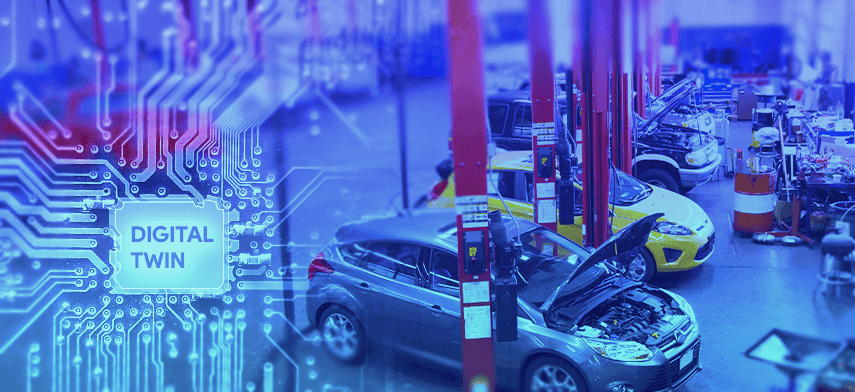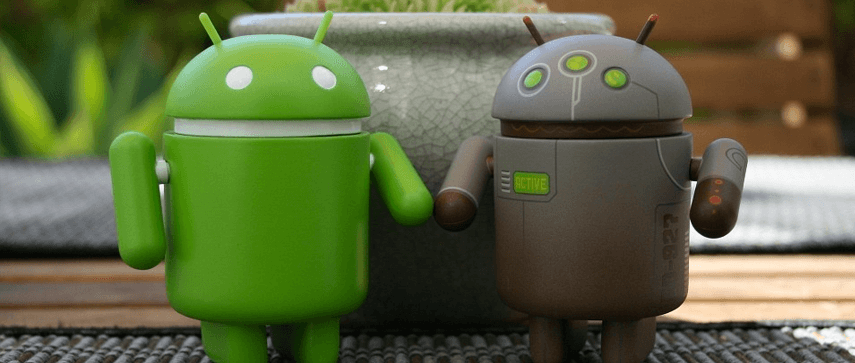The automotive industry has been one of the most disruptive in the past few years. A look at Tesla can tell you how automotive technology has advanced. The market for automobiles was strong around the globe, but then 2020 came.

COVID-19 hit car manufacturers hard worldwide. From dipping sales to complete shutdown, the effects of coronavirus have been devastating. According to BCG, automobile sales in the US and Europe shall take at least another 2 years to reach pre-COVID figures.
Car manufacturers need to adopt an agile and data-driven approach to survive and thrive in these uncertain times. Being able to predict the worst and how it shall affect your manufacturing is the trick to excel.
In this regard, digital twin technology emerges as a fitting solution to resolve the problems of the automobile industry.
Let’s explore how that is possible.
What is Digital Twinning and its Significant Characteristics?
A concise definition of the digital twin is the culmination of physical and digital environments to facilitate the exchange of data to solve problems. You can make a digital copy of your manufacturing processes, products, machinery, human resources, and more.
The virtual copy shall be like a twin of the physical realm, identical in every aspect. This digital model is enriched by data collected by sensors. You can then use this to create a copy of the physical device in real-time.
Digital twin uses technologies like:
- Internet of Things (IoT)
- Artificial intelligence (AI)
- Machine learning (ML)
- Predictive analysis
- Simulation tools
Let us take an example to make things clear. If you’re designing a new safety system for your car then you have to conduct collision tests in order to develop your product. However, you can eliminate the costly and time-taking process by creating a digital twin of your safety system.
You can then conduct tests in virtual settings, created with real-world data brought in from sensors and more. As a result, you don’t need to wait for months to update your vehicle safety. Plus, you can discover all flaws in your design early on to avoid physical rework.
Characteristics of Digital Twin Technology
Digital twin technology helps get work done quicker and better. It has the capacity to transform the entire manufacturing value chain. From automotive product development to testing over the air software updates, your virtual twin can come in handy every time.
Here’re some more characteristics to be taken into consideration.
Smart
The digital copy of your systems and processes is smart enough to predict any disruptions or errors in your product. Driven by AI, data processing is able to provide meaningful insights on your products, manufacturing process, supply chain, and more. Plus, the technology can learn from behaviors and historical data for additional accuracy.
Real-Time
All physical and virtual worlds you get are real-time or close to it. The system continuously updates itself based on data from the ground to stay relevant and effective. Any change shall quickly reflect on the virtual model without any exceptions. This characteristic makes digital twinning a valid and legit technology.
Repeatable
You can use digital twin technology for any manufacturing process or product development. It is highly customizable and can adapt to various environments and operating conditions. Furthermore, you can reprogram the model as you need to fit your application.
Connective
The digital twin of your physical processes is not just a static replica. It is the bridge between the physical and virtual universe and enables the seamless flow of data. Any organization can begin with a digital twin in their efforts of digital transformation.
Accuracy
The predictions made based on your digital twin are highly accurate. You can rely on the real-world data sent in by sensors to forecast supply chain interruptions or test your product. Any simulation you create is likely to replicate the real-world results as you are using accurate and real-time data.

Role of Digital Twins in Addressing Current Automotive Challenges
Digital twins can help the automotive industry solve countless challenges. Some of the common issues faced are data inaccuracy, downtime, or insufficient data to understand customers’ needs.
1 Unifying Data
Automobile manufacturing has to work with a wide range of data. Historical data of previous models, performance data, driver behaviors – the list is endless. Digital twin resolves this challenge easily by integrating data from several sources. The manufacturer can analyze and evaluate the data to derive any insight.
2 Easy Verifications
Automobile companies spend a lot of time verifying new features or designs. They have to wait for production to determine the feasibility of their designs. Naturally, the process is time-consuming and increases the time to market. A digital twin can provide a quick and reliable way of verifying designs. It can source all the required data to run simulations that provide accurate results.
3 Prevent Failures
Any machine is bound to suffer downtime or malfunction. That brings a halt to your production and takes a toll on your revenues. Digital twin technology can use data to predict when downtimes can occur. Additionally, it can even learn from past data and take steps to avoid such malfunctions. Your production goes on uninterrupted without any financial loss.
4 Predict Customer Demands
Manufacturers seldom get to know what customers feel or want, as the data never reaches them. Using digital twins, you can even collect data after cars are on the road. For example, manufacturers shall be able to see which features are being most used by customers. As a result, manufacturers can get better at predicting customer demand. They can make products that customers love and are ready to pay for.
Digital twin technology has the needed capabilities to boost the automobile industry. Let’s take a look.
Applications of Digital Twinning Technology in the Automobile Industry
A digital twin is ripe for application in different stages of the automobile manufacturing process. It shall significantly reduce the challenges and improve the degree of efficiency. Right from product development to maintenance, a digital twin can be of immense help.
Let’s find out how!
Product Development
A digital twin can aid the whole automotive product development life cycle. In fact, it can help manufactures develop reliable products quickly and efficiently. You can integrate the data from previous vehicles and combine it with the digital copy of your new vehicle.
It can improve the effectiveness of your simulations and help in the decision-making process. In addition to that, the technology can facilitate communication between engineers, developers, and even customers. So, manufacturers have all the data to walk in the right direction.
Product Manufacturing
You can count on digital twins to facilitate many processes during production. We have already discussed how manufacturers can predict and prevent machine downtime. In the same way, digital twins can help in creating a safe working environment and avoiding accidents.
Additionally, the system can control advanced manufacturing techniques, like automated guided vehicles. It can direct autonomous robots and equipment to work without human intervention. The technology can even help in reducing the complexity of the automobile manufacturing process.
Sales
The customers may want to pay only for specific features they use in the car. A virtual twin of each customer vehicle can help manufacturers activate or deactivate any feature over the air. They can get insight in real-time into the car’s usage and make way for the car ownership model of the future.
Moreover, a digital twin can go a long way in improving customer management. Traditionally, manufacturers seldom involved themselves in customer handling. But now, they can’t afford to miss out on the process as it can mean a loss of revenues. It can help dealers and manufacturers get a complete picture of customer preferences and behavior.
Maintenance and Servicing
Data collected by digital twin can help in determining the condition of vehicles. It can assist owners in keeping track of their servicing requirements. Manufacturers can also find out the parts in demand, produce them strategically, and push software or firmware updates. It can help track and record ownership data, maintenance requirements, and more.
Manufacturers can reduce their warranty costs and find out how their products are performing. They can quickly call back any batch if needed and even get proactive by predicting breakdowns. As a result, manufacturers can protect their reputation and brand image. They can also use the digital twin to gather customer feedback without conducting a survey or personal contact.
Final Thoughts
Digital twin technology is emerging as a ripe solution to resolve the challenges experienced by the automobile industry. It can bring much-needed digitization and provide a platform to drive data-backed decisions. Manufacturers can apply the technology in all stages of the production process and remove uncertainties and flaws.
They can come up with new and better solutions than their competitors to attract more customers. From product ideation to servicing, digital twins are proving worthy of mass adoption. As such, the world is going to experience more exciting uses of the digital twin in the coming years.

Author's Bio

Nitin Lahoti is the Co-Founder and Director at Mobisoft Infotech. He has 15 years of experience in Design, Business Development and Startups. His expertise is in Product Ideation, UX/UI design, Startup consulting and mentoring. He prefers business readings and loves traveling.


